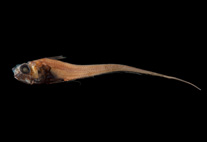Abstract
The fishes of the genus Hymenocephalus live over continental slope terrain, chiefly between 300 and 1000 m water depths, in all tropical oceans, except the eastern Pacific. They are characterized by an elongated light organ with two lenses, striations on jugular and thorax, and by an extraordinary development of sensory reception organs: strongly enlarged eyes, exceptionally large and specialized sagittal otoliths and extremely wide and deep head canals resembling caverns and housing the cephalic sensory organ for motion reception (lateral line system).
The purpose of this study is to evaluate the potential that a detailed analysis of the head and otolith morphology can offer for distinguishing the various species and assessment of their interrelationships. About 500 specimens were investigated, representing all 22 nominal species of the genus Hymenocephalus, except for H. barbatulus (specimens of which could not be located), the two species of the related genus Hymenogadus and three of the four species of Spicomacrurus. Because of the delicate and thin nature of the head bones and head skin typical for the fishes of the genus Hymenocephalus and the deteriorating effects of formalin to the aragonitic otoliths, only a fraction of the studied specimens actually contributed useful data, although that fraction represented all species studied.
Otoliths in particular and aspects of the cephalic canal system were found to contribute additional characters that help to verify the status of certain controversial species such as H. heterolepis, H. nascens and species within the H. striatissimus and H. grimaldii Groups. Hymenocephalus longiceps is revised to represent a junior synonym of H. longibarbis. Eight species groups are defined within the genus Hymenocephalus. Three new species are being described in the course of this review: H. iwamotoi from off northwestern Australia, H. sazonovi from the Sala y Gomez and Nazca Ridges, and H. punt from northern Somalia and the Gulf of Aden, now raising the count of valid species in the genus to a total of 24.
The specializations of the sensory reception organs show a variety of developments with well-expressed phylogenetic polarities that are discussed in the context of their evolution and interrelationships. A well-documented case of polarity reversal of certain characters in the H. aterrimus Group is interpreted as a functional adaptation to migration of these fishes into a deeper water environment that favors different specializations of the sensory reception.

